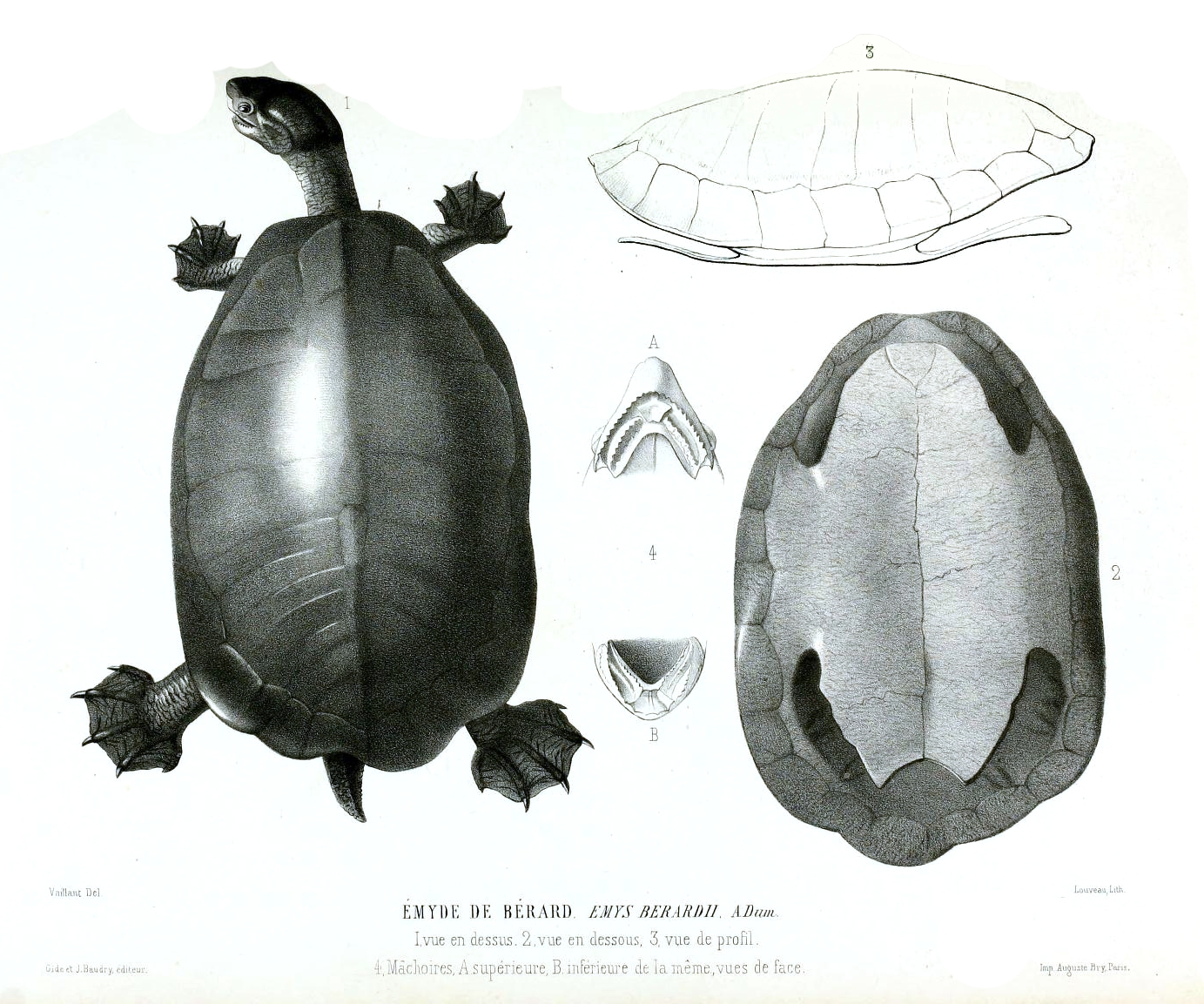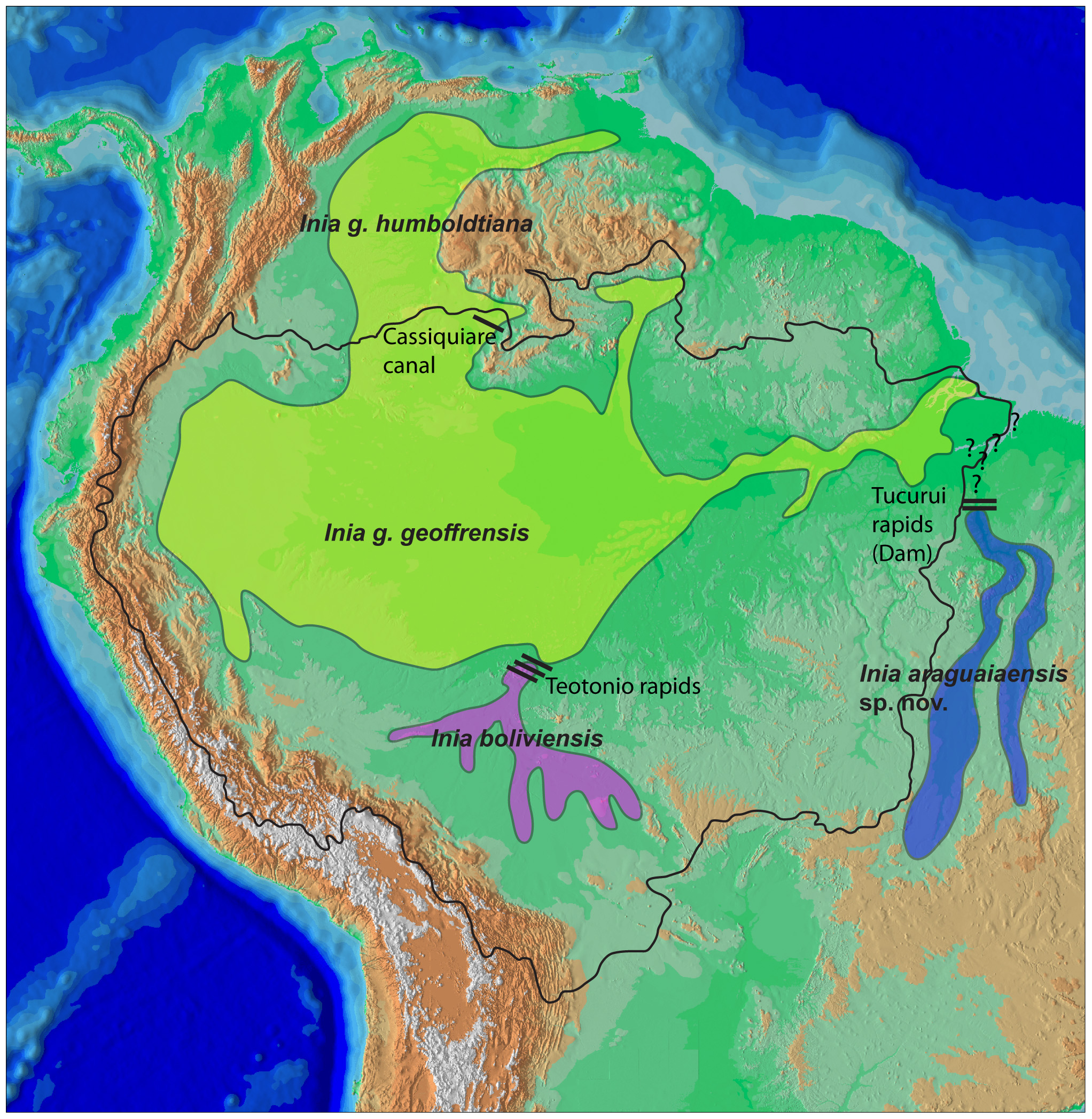|
Pink River Dolphin
The Amazon river dolphin (''Inia geoffrensis''), also known as the boto, bufeo or pink river dolphin, is a species of toothed whale classified in the family Iniidae. Three subspecies are currently recognized: ''I. g. geoffrensis'' (Amazon river dolphin), ''I. g. boliviensis'' (Bolivian river dolphin) and ''I. g. humboldtiana'' (Orinoco river dolphin) while position of Araguaian river dolphin (''I. araguaiaensis'') within the clade is still unclear. The three subspecies are distributed in the Amazon basin, the upper Madeira River in Bolivia, and the Orinoco basin, respectively. The Amazon river dolphin is the largest species of river dolphin, with adult males reaching in weight, and in length. Adults acquire a pink color, more prominent in males, giving it its nickname "pink river dolphin". Sexual dimorphism is very evident, with males measuring 16% longer and weighing 55% more than females. Like other toothed whales, they have a melon, an organ that is used for bio sonar. Th ... [...More Info...] [...Related Items...] OR: [Wikipedia] [Google] [Baidu] |
Henri Marie Ducrotay De Blainville
Henri Marie Ducrotay de Blainville (; 12 September 1777 – 1 May 1850) was a French zoologist and anatomist. Life Blainville was born at Arques, near Dieppe. As a young man he went to Paris to study art, but ultimately devoted himself to natural history. He attracted the attention of Georges Cuvier, for whom he occasionally substituted as lecturer at the Collège de France and at the Athenaeum Club, London. In 1812 he was aided by Cuvier in acquiring the position of assistant professor of anatomy and zoology in the Faculty of Sciences at Paris. Eventually, relations between the two men soured, a situation that ended in open enmity. In 1819, Blainville was elected a member of the American Philosophical Society in Philadelphia. In 1825 he was admitted a member of the French Academy of Sciences; and in 1830 he was appointed to succeed Jean-Baptiste Lamarck in the chair of natural history at the museum. Two years later, on the death of Cuvier, he obtained the chair of comparative a ... [...More Info...] [...Related Items...] OR: [Wikipedia] [Google] [Baidu] |
River Turtle
The hickatee (''Dermatemys mawii'') or in Spanish ''tortuga blanca'' ('white turtle'), also called the Central American river turtle, is the only living species in the family Dermatemydidae. The species is found in the Atlantic drainages of Central America, specifically Belize, Guatemala, southern Mexico and probably Honduras. It is a relatively large-bodied species, with records of straight carapace length and weights of ; although most individuals are smaller. This is a herbivorous and almost completely aquatic turtle that does not even surface to bask. Bizarrely for reptiles, the eggs can remain viable even after being underwater for weeks -in the recent past, some scientists mistakenly claimed it nests underwater, likely due to visiting Central America during a frequent flood, when nests are often submerged. In the culture of the Ancient Mayan civilisation this species and turtles in general had numerous uses such as being used in warfare, as musical instruments and as foo ... [...More Info...] [...Related Items...] OR: [Wikipedia] [Google] [Baidu] |
Tocantins River
The Tocantins River ( pt, Rio Tocantins, link=no , , Parkatêjê dialect, Parkatêjê: ''Pyti'' [pɨˈti]) is a river in Brazil, the central fluvial artery of the country. In the Tupi language, its name means "toucan's beak" (''Tukã'' for "toucan" and ''Ti'' for "beak"). It runs from south to north for about 2,450 km. It is not really a branch of the Amazon River, since its waters flow into the Atlantic Ocean alongside those of the Amazon. It flows through four Brazilian states (Goiás, Tocantins, Maranhão and Pará) and gives its name to one of Brazil's newest states, formed in 1988 from what was until then the northern portion of Goiás. The Tocantins is one of the largest Clearwater river (river type), clearwater rivers in South America. Course It rises in the mountainous district known as the Pirineus State Park, Pireneus, west of the Federal District, but its western tributary, the Araguaia River, has its extreme southern headwaters on the slopes of the Serra dos Cai ... [...More Info...] [...Related Items...] OR: [Wikipedia] [Google] [Baidu] |
Putumayo River
The Putumayo River or Içá River ( es, Río Putumayo, pt, Rio Içá) is one of the tributaries of the Amazon River, southwest of and parallel to the Japurá River. Course The Putumayo River forms part of Colombia's border with Ecuador, as well as most of the border with Peru. Known as the Putumayo in the former three nations, it is called the Içá when it crosses into Brazil. The Putumayo originates in the Andes Mountains east of the city of Pasto, Colombia. It empties into the Solimões (upper Amazon) near the municipality of Santo Antônio do Içá, Brazil. Major tributaries include the Guamués River, San Miguel, Güeppí, Cumpuya, Algodón, Igara-Paraná, Yaguas, Cotuhé, and Paraná de Jacurapá rivers. The river flows through the Solimões-Japurá moist forests ecoregion. History Exploration In the late 19th century, the Içá was navigated by the French explorer Jules Crevaux (1847–1882). He ascended it in a steamer drawing of water, and running day and night. H ... [...More Info...] [...Related Items...] OR: [Wikipedia] [Google] [Baidu] |
Society For Marine Mammalogy
The Society for Marine Mammalogy was founded in 1981 and is the largest international association of marine mammal scientists in the world. Mission The mission of the Society for Marine Mammalogy (SMM) is to promote the global advancement of marine mammal science and contribute to its relevance and impact in education, conservation and management. Objectives * Evaluate and promote the educational, scientific and managerial advancement of marine mammal science. * Gather and disseminate to members of the Society, the public, and public and private institutions, scientific, technical and management information through publications and meetings. * Provide scientific information, as required, on matters related to the conservation and management of marine mammal resources. History The Biennial Conferences on the Biology of Marine Mammals predate the founding of the Society. The Biennial Conferences were a successor to Tom Poulter's "Annual Conference on Biological Sonar and Diving M ... [...More Info...] [...Related Items...] OR: [Wikipedia] [Google] [Baidu] |
Miocene
The Miocene ( ) is the first geological epoch of the Neogene Period and extends from about (Ma). The Miocene was named by Scottish geologist Charles Lyell; the name comes from the Greek words (', "less") and (', "new") and means "less recent" because it has 18% fewer modern marine invertebrates than the Pliocene has. The Miocene is preceded by the Oligocene and is followed by the Pliocene. As Earth went from the Oligocene through the Miocene and into the Pliocene, the climate slowly cooled towards a series of ice ages. The Miocene boundaries are not marked by a single distinct global event but consist rather of regionally defined boundaries between the warmer Oligocene and the cooler Pliocene Epoch. During the Early Miocene, the Arabian Peninsula collided with Eurasia, severing the connection between the Mediterranean and Indian Ocean, and allowing a faunal interchange to occur between Eurasia and Africa, including the dispersal of proboscideans into Eurasia. During the ... [...More Info...] [...Related Items...] OR: [Wikipedia] [Google] [Baidu] |
Inioidea
River dolphins are a polyphyletic group of fully aquatic mammals that reside exclusively in freshwater or brackish water. They are an informal grouping of dolphins, which itself is a paraphyletic group within the infraorder Cetacea. Extant river dolphins are placed in two superfamilies, Platanistoidea and Inioidea. They comprise the families Platanistidae (the South Asian dolphins), the recently extinct Lipotidae (Yangtze river dolphin), Iniidae (the Amazonian dolphins) and Pontoporiidae. There are five extant species of river dolphins. River dolphins, alongside other cetaceans, belong to the clade Artiodactyla, with even-toed ungulates, and their closest living relatives the hippopotamuses, from which they diverged about 40 million years ago. Specific types of Dolphins can be pink. River dolphins are relatively small compared to other dolphins, having evolved to survive in warm, shallow water and strong river currents. They range in size from the long South Asian river dol ... [...More Info...] [...Related Items...] OR: [Wikipedia] [Google] [Baidu] |
Paraphyletic
In taxonomy (general), taxonomy, a group is paraphyletic if it consists of the group's most recent common ancestor, last common ancestor and most of its descendants, excluding a few Monophyly, monophyletic subgroups. The group is said to be paraphyletic ''with respect to'' the excluded subgroups. In contrast, a monophyletic group (a clade) includes a common ancestor and ''all'' of its descendants. The terms are commonly used in phylogenetics (a subfield of biology) and in the tree model of historical linguistics. Paraphyletic groups are identified by a combination of Synapomorphy and apomorphy, synapomorphies and symplesiomorphy, symplesiomorphies. If many subgroups are missing from the named group, it is said to be polyparaphyletic. The term was coined by Willi Hennig to apply to well-known taxa like Reptilia (reptiles) which, as commonly named and traditionally defined, is paraphyletic with respect to mammals and birds. Reptilia contains the last common ancestor of reptiles a ... [...More Info...] [...Related Items...] OR: [Wikipedia] [Google] [Baidu] |
Platanistoidea
River dolphins are a polyphyletic group of fully aquatic mammals that reside exclusively in freshwater or brackish water. They are an informal grouping of dolphins, which itself is a paraphyletic group within the infraorder Cetacea. Extant river dolphins are placed in two superfamilies, Platanistoidea and Inioidea. They comprise the families Platanistidae (the South Asian dolphins), the recently extinct Lipotidae (Yangtze river dolphin), Iniidae (the Amazonian dolphins) and Pontoporiidae. There are five extant species of river dolphins. River dolphins, alongside other cetaceans, belong to the clade Artiodactyla, with even-toed ungulates, and their closest living relatives the hippopotamuses, from which they diverged about 40 million years ago. Specific types of Dolphins can be pink. River dolphins are relatively small compared to other dolphins, having evolved to survive in warm, shallow water and strong river currents. They range in size from the long South Asian river dolp ... [...More Info...] [...Related Items...] OR: [Wikipedia] [Google] [Baidu] |
Inia
''Inia'' is a genus of river dolphins from South America containing one to four species. Taxonomy The genus was described by Alcide d'Orbigny in 1834 when ''Delphinus geoffrensis'', described by Henri Marie Ducrotay de Blainville in 1817, was recognized to be a unique taxon. A 1998 classification listed a single species, ''Inia geoffrensis'', in the genus ''Inia'', with three recognized subspecies. Most of the scientific community accepted this single species classification, as does the IUCN. As of 2016 the Committee on Taxonomy of the Society for Marine Mammalogy considers the genus ''Inia'' to contain one species with only two subspecies: the Bolivian (''I. g. boliviensis'') and the Amazon (''I. g. geoffrensis)'' subspecies. In 2014, the population in the Araguaia-Tocantins basin was proposed to define an additional species, ''Inia araguaiaensis'', but this remains debated. The American Society of Mammalogists recognizes the highest number of species at four, although this i ... [...More Info...] [...Related Items...] OR: [Wikipedia] [Google] [Baidu] |
River Dolphin
River dolphins are a polyphyletic group of fully aquatic mammals that reside exclusively in freshwater or brackish water. They are an informal grouping of dolphins, which itself is a paraphyletic group within the infraorder Cetacea. Extant river dolphins are placed in two superfamilies, Platanistoidea and Inioidea. They comprise the families Platanistidae (the South Asian dolphins), the recently extinct Lipotidae (Yangtze river dolphin), Iniidae (the Amazonian dolphins) and Pontoporiidae. There are five extant species of river dolphins. River dolphins, alongside other cetaceans, belong to the clade Artiodactyla, with even-toed ungulates, and their closest living relatives the hippopotamuses, from which they diverged about 40 million years ago. Specific types of Dolphins can be pink. River dolphins are relatively small compared to other dolphins, having evolved to survive in warm, shallow water and strong river currents. They range in size from the long South Asian river dolp ... [...More Info...] [...Related Items...] OR: [Wikipedia] [Google] [Baidu] |






.jpg)
